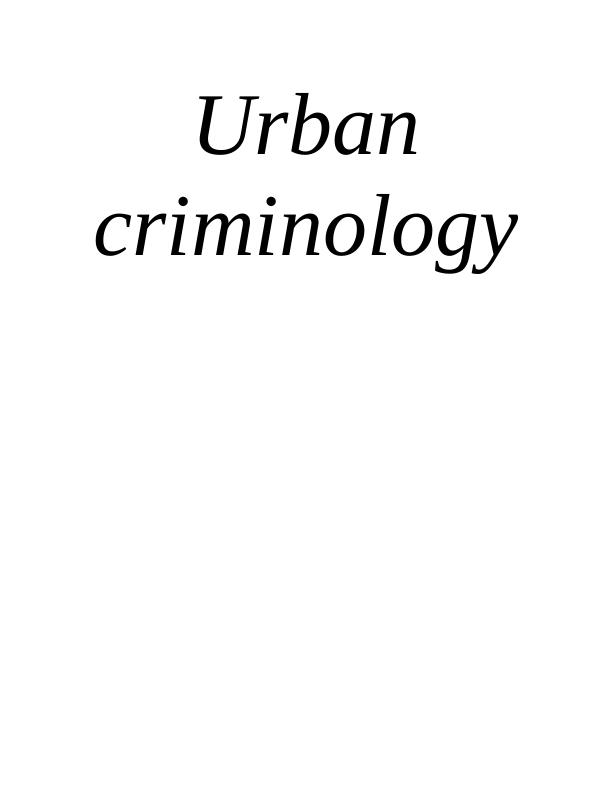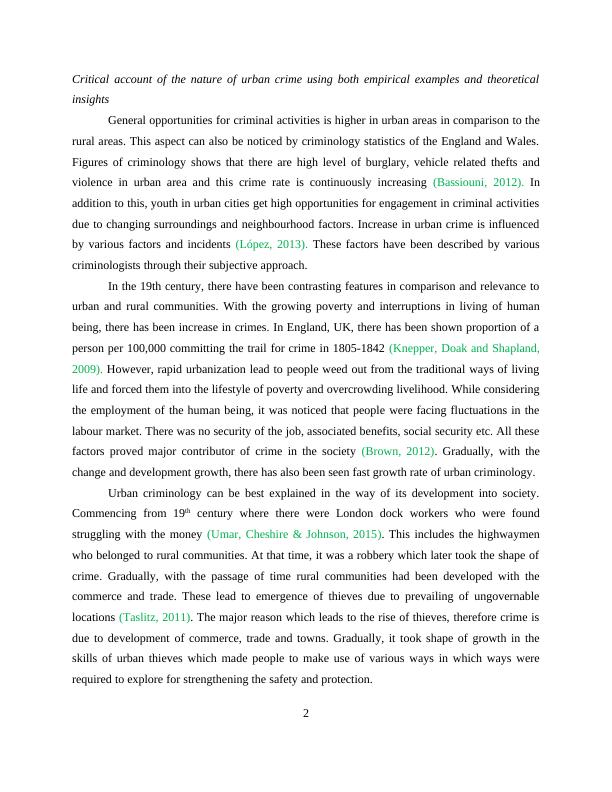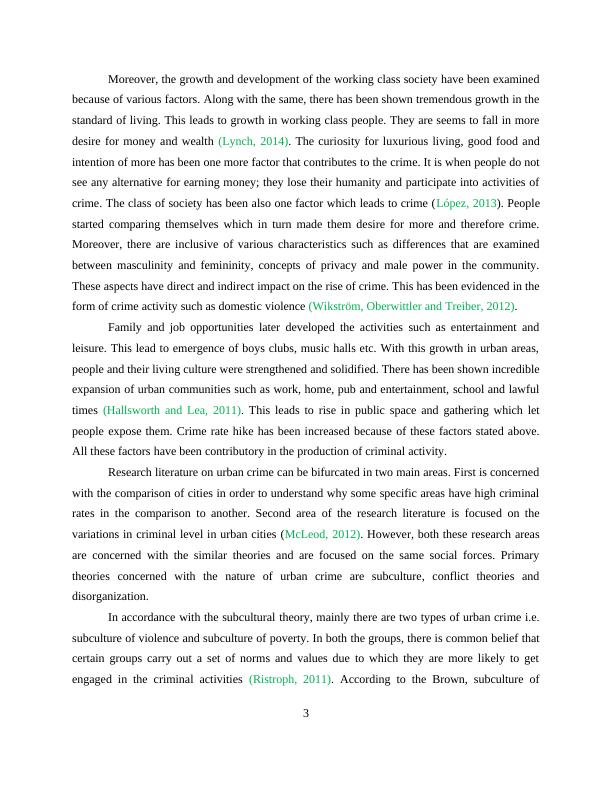Urban Criminology : Assignment
11 Pages3517 Words51 Views
Added on 2020-01-23
Urban Criminology : Assignment
Added on 2020-01-23
ShareRelated Documents
Urban
criminology
criminology

Critical account of the nature of urban crime using both empirical examples and theoretical
insights
General opportunities for criminal activities is higher in urban areas in comparison to the
rural areas. This aspect can also be noticed by criminology statistics of the England and Wales.
Figures of criminology shows that there are high level of burglary, vehicle related thefts and
violence in urban area and this crime rate is continuously increasing (Bassiouni, 2012). In
addition to this, youth in urban cities get high opportunities for engagement in criminal activities
due to changing surroundings and neighbourhood factors. Increase in urban crime is influenced
by various factors and incidents (López, 2013). These factors have been described by various
criminologists through their subjective approach.
In the 19th century, there have been contrasting features in comparison and relevance to
urban and rural communities. With the growing poverty and interruptions in living of human
being, there has been increase in crimes. In England, UK, there has been shown proportion of a
person per 100,000 committing the trail for crime in 1805-1842 (Knepper, Doak and Shapland,
2009). However, rapid urbanization lead to people weed out from the traditional ways of living
life and forced them into the lifestyle of poverty and overcrowding livelihood. While considering
the employment of the human being, it was noticed that people were facing fluctuations in the
labour market. There was no security of the job, associated benefits, social security etc. All these
factors proved major contributor of crime in the society (Brown, 2012). Gradually, with the
change and development growth, there has also been seen fast growth rate of urban criminology.
Urban criminology can be best explained in the way of its development into society.
Commencing from 19th century where there were London dock workers who were found
struggling with the money (Umar, Cheshire & Johnson, 2015). This includes the highwaymen
who belonged to rural communities. At that time, it was a robbery which later took the shape of
crime. Gradually, with the passage of time rural communities had been developed with the
commerce and trade. These lead to emergence of thieves due to prevailing of ungovernable
locations (Taslitz, 2011). The major reason which leads to the rise of thieves, therefore crime is
due to development of commerce, trade and towns. Gradually, it took shape of growth in the
skills of urban thieves which made people to make use of various ways in which ways were
required to explore for strengthening the safety and protection.
2
insights
General opportunities for criminal activities is higher in urban areas in comparison to the
rural areas. This aspect can also be noticed by criminology statistics of the England and Wales.
Figures of criminology shows that there are high level of burglary, vehicle related thefts and
violence in urban area and this crime rate is continuously increasing (Bassiouni, 2012). In
addition to this, youth in urban cities get high opportunities for engagement in criminal activities
due to changing surroundings and neighbourhood factors. Increase in urban crime is influenced
by various factors and incidents (López, 2013). These factors have been described by various
criminologists through their subjective approach.
In the 19th century, there have been contrasting features in comparison and relevance to
urban and rural communities. With the growing poverty and interruptions in living of human
being, there has been increase in crimes. In England, UK, there has been shown proportion of a
person per 100,000 committing the trail for crime in 1805-1842 (Knepper, Doak and Shapland,
2009). However, rapid urbanization lead to people weed out from the traditional ways of living
life and forced them into the lifestyle of poverty and overcrowding livelihood. While considering
the employment of the human being, it was noticed that people were facing fluctuations in the
labour market. There was no security of the job, associated benefits, social security etc. All these
factors proved major contributor of crime in the society (Brown, 2012). Gradually, with the
change and development growth, there has also been seen fast growth rate of urban criminology.
Urban criminology can be best explained in the way of its development into society.
Commencing from 19th century where there were London dock workers who were found
struggling with the money (Umar, Cheshire & Johnson, 2015). This includes the highwaymen
who belonged to rural communities. At that time, it was a robbery which later took the shape of
crime. Gradually, with the passage of time rural communities had been developed with the
commerce and trade. These lead to emergence of thieves due to prevailing of ungovernable
locations (Taslitz, 2011). The major reason which leads to the rise of thieves, therefore crime is
due to development of commerce, trade and towns. Gradually, it took shape of growth in the
skills of urban thieves which made people to make use of various ways in which ways were
required to explore for strengthening the safety and protection.
2

Moreover, the growth and development of the working class society have been examined
because of various factors. Along with the same, there has been shown tremendous growth in the
standard of living. This leads to growth in working class people. They are seems to fall in more
desire for money and wealth (Lynch, 2014). The curiosity for luxurious living, good food and
intention of more has been one more factor that contributes to the crime. It is when people do not
see any alternative for earning money; they lose their humanity and participate into activities of
crime. The class of society has been also one factor which leads to crime (López, 2013). People
started comparing themselves which in turn made them desire for more and therefore crime.
Moreover, there are inclusive of various characteristics such as differences that are examined
between masculinity and femininity, concepts of privacy and male power in the community.
These aspects have direct and indirect impact on the rise of crime. This has been evidenced in the
form of crime activity such as domestic violence (Wikström, Oberwittler and Treiber, 2012).
Family and job opportunities later developed the activities such as entertainment and
leisure. This lead to emergence of boys clubs, music halls etc. With this growth in urban areas,
people and their living culture were strengthened and solidified. There has been shown incredible
expansion of urban communities such as work, home, pub and entertainment, school and lawful
times (Hallsworth and Lea, 2011). This leads to rise in public space and gathering which let
people expose them. Crime rate hike has been increased because of these factors stated above.
All these factors have been contributory in the production of criminal activity.
Research literature on urban crime can be bifurcated in two main areas. First is concerned
with the comparison of cities in order to understand why some specific areas have high criminal
rates in the comparison to another. Second area of the research literature is focused on the
variations in criminal level in urban cities (McLeod, 2012). However, both these research areas
are concerned with the similar theories and are focused on the same social forces. Primary
theories concerned with the nature of urban crime are subculture, conflict theories and
disorganization.
In accordance with the subcultural theory, mainly there are two types of urban crime i.e.
subculture of violence and subculture of poverty. In both the groups, there is common belief that
certain groups carry out a set of norms and values due to which they are more likely to get
engaged in the criminal activities (Ristroph, 2011). According to the Brown, subculture of
3
because of various factors. Along with the same, there has been shown tremendous growth in the
standard of living. This leads to growth in working class people. They are seems to fall in more
desire for money and wealth (Lynch, 2014). The curiosity for luxurious living, good food and
intention of more has been one more factor that contributes to the crime. It is when people do not
see any alternative for earning money; they lose their humanity and participate into activities of
crime. The class of society has been also one factor which leads to crime (López, 2013). People
started comparing themselves which in turn made them desire for more and therefore crime.
Moreover, there are inclusive of various characteristics such as differences that are examined
between masculinity and femininity, concepts of privacy and male power in the community.
These aspects have direct and indirect impact on the rise of crime. This has been evidenced in the
form of crime activity such as domestic violence (Wikström, Oberwittler and Treiber, 2012).
Family and job opportunities later developed the activities such as entertainment and
leisure. This lead to emergence of boys clubs, music halls etc. With this growth in urban areas,
people and their living culture were strengthened and solidified. There has been shown incredible
expansion of urban communities such as work, home, pub and entertainment, school and lawful
times (Hallsworth and Lea, 2011). This leads to rise in public space and gathering which let
people expose them. Crime rate hike has been increased because of these factors stated above.
All these factors have been contributory in the production of criminal activity.
Research literature on urban crime can be bifurcated in two main areas. First is concerned
with the comparison of cities in order to understand why some specific areas have high criminal
rates in the comparison to another. Second area of the research literature is focused on the
variations in criminal level in urban cities (McLeod, 2012). However, both these research areas
are concerned with the similar theories and are focused on the same social forces. Primary
theories concerned with the nature of urban crime are subculture, conflict theories and
disorganization.
In accordance with the subcultural theory, mainly there are two types of urban crime i.e.
subculture of violence and subculture of poverty. In both the groups, there is common belief that
certain groups carry out a set of norms and values due to which they are more likely to get
engaged in the criminal activities (Ristroph, 2011). According to the Brown, subculture of
3

violence states that high violence rate is consequence of the culture where general criminology
believes that violence is an acceptable form of behaviour. In addition to this, carriers of the
subculture of violence are quicker in comparison to the other activities (Brown, 2012). It is
because; situation that normally generates anger in an individual is able to provoke violence. For
the formulation of such ideas, various criminologists believe that social institutions contribute for
the development and persistence of a subculture conducive to violence and criminality. For this
aspect, example of disintegration by various institutions can be considered such as families,
schools and churches. These institutions do not consider certain individuals (minorities) for the
learning opportunities, values and conventional norms. Theoretically, they promote equality but
in practical life they consider discrimination (Ristroph, 2011). Consequently, certain groups have
more violent behaviour as they are aggressive towards the society and for them, violence is an
acceptable means for solving the situation or for taking revenge.
According to the study of Graham Dewhirst, generally in main urban areas, the number
of crimes recorded (per 1000 of population) is significantly greater than in comparison to the
rural areas. As per their study, urban crime rate is 130 in comparison to the rural crime rate of
50.2 (McLeod, 2012). However, the gap between these crime rates has been reduced drastically
over the past four years. It is because, in 2011-12 this was gap of 95.8 and at present is only 79.8.
This aspect shows there is reduction of 17.5% in criminal rates (Zhang, Goyal and Sinha, 2015).
Comparison of crime in urban and rural areas show that criminal activities are bifurcated
in various categories. For burglary rate of reduction in crime in urban area is double in
comparison to the rural areas (Crawford, 2011). With the changing environment, urban area is
developing and consequently there is improvement in the security aspects. However, for the
criminal damage and arson rate of reduction in rural area is higher than urban areas. It is because,
individual residing in the urban areas are more aggressive and short tempered due to daily
activities (Lynch, 2014). As a consequence, they are more likely to get engaged in the criminal
activities. In accordance with their point of view, it is remedy for their loss occurred to them due
to society. Violence and sexual offenses are continuously increasing in both urban and rural
areas. People are using violence for their mental relief and due to this they are hurting weaker
party physically and mentally.
4
believes that violence is an acceptable form of behaviour. In addition to this, carriers of the
subculture of violence are quicker in comparison to the other activities (Brown, 2012). It is
because; situation that normally generates anger in an individual is able to provoke violence. For
the formulation of such ideas, various criminologists believe that social institutions contribute for
the development and persistence of a subculture conducive to violence and criminality. For this
aspect, example of disintegration by various institutions can be considered such as families,
schools and churches. These institutions do not consider certain individuals (minorities) for the
learning opportunities, values and conventional norms. Theoretically, they promote equality but
in practical life they consider discrimination (Ristroph, 2011). Consequently, certain groups have
more violent behaviour as they are aggressive towards the society and for them, violence is an
acceptable means for solving the situation or for taking revenge.
According to the study of Graham Dewhirst, generally in main urban areas, the number
of crimes recorded (per 1000 of population) is significantly greater than in comparison to the
rural areas. As per their study, urban crime rate is 130 in comparison to the rural crime rate of
50.2 (McLeod, 2012). However, the gap between these crime rates has been reduced drastically
over the past four years. It is because, in 2011-12 this was gap of 95.8 and at present is only 79.8.
This aspect shows there is reduction of 17.5% in criminal rates (Zhang, Goyal and Sinha, 2015).
Comparison of crime in urban and rural areas show that criminal activities are bifurcated
in various categories. For burglary rate of reduction in crime in urban area is double in
comparison to the rural areas (Crawford, 2011). With the changing environment, urban area is
developing and consequently there is improvement in the security aspects. However, for the
criminal damage and arson rate of reduction in rural area is higher than urban areas. It is because,
individual residing in the urban areas are more aggressive and short tempered due to daily
activities (Lynch, 2014). As a consequence, they are more likely to get engaged in the criminal
activities. In accordance with their point of view, it is remedy for their loss occurred to them due
to society. Violence and sexual offenses are continuously increasing in both urban and rural
areas. People are using violence for their mental relief and due to this they are hurting weaker
party physically and mentally.
4

End of preview
Want to access all the pages? Upload your documents or become a member.
Related Documents
Criminology Theory and Strain Theory : Reportlg...
|8
|3051
|139
Green Criminology and its Importance in the 21st Centurylg...
|9
|2796
|279
Contemporary Issues in Criminology and Criminal Justicelg...
|5
|991
|272
The History of United Kingdomlg...
|10
|2946
|23
Development of Social Policy on Poverty and Attitudes to Poverty from the 19th Century to Present Daylg...
|8
|2426
|308
EFFECT OF GLOBALIZATION IN CRIME AND CRIMINOLOGYlg...
|12
|3320
|94
